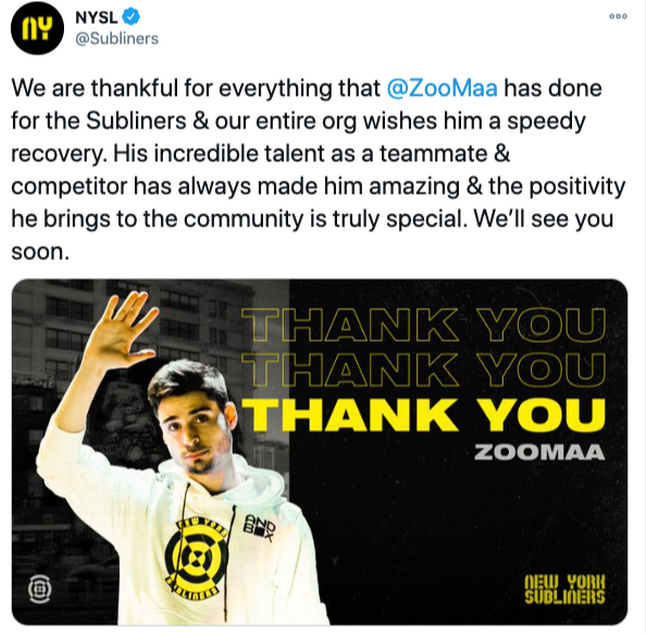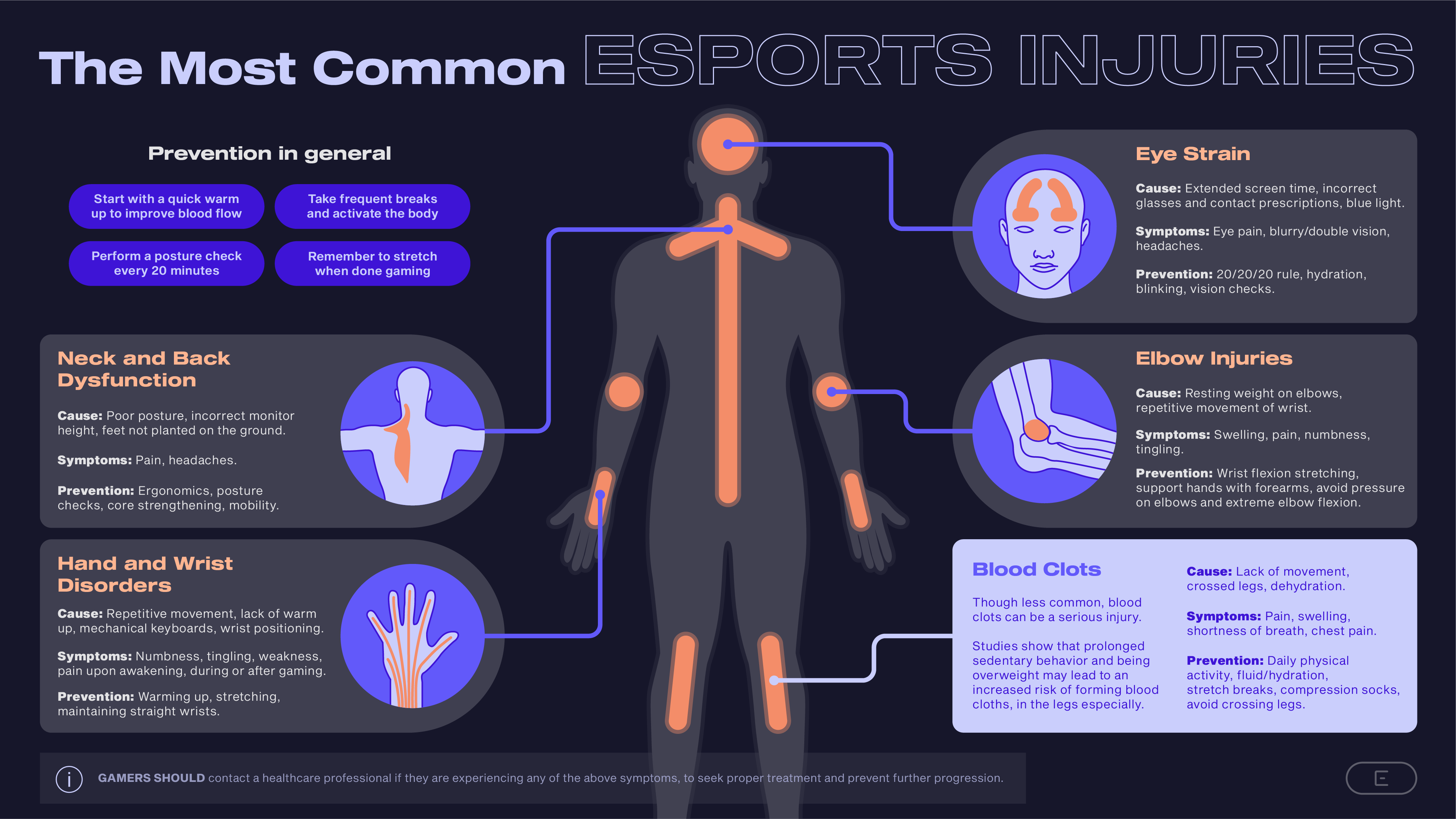Careers Cut Short – Gaming Injuries: The Real Toll of Unhealthy Habits in Esports
Every day, millions of kids throughout the United States play video games. Some are just letting off steam or goofing off with friends, but many are trying to gain skills and learn valuable lessons that may help them with their secret desire to one day go pro.
Sadly, going it alone, kids can develop a number of health issues ranging from depression to carpal tunnel, or what the kids call ‘nerd neck’ a forward head posture where the skull actually floats one or more inches in front of the cervical spine.
Researchers have shown that kids who play esports with a team that’s coached by a professional adult can perform better in school, have lower rates of depression, substance use, and obesity, and grow up to be more active, productive adults than kids who do not.
Unlike traditional sports, esports is not impacted by the weather. And unlike school sports that correlate to educational calendars, club esports is supported year-round.
This is why a growing number of parents are opting to enroll their children in a sports club, with Esports Tower being the premier training club.
Early Retirement – aching joints and the unexpected physical pains of esports
Early last year, Thomas “ZooMaa” Paparatto, at the time a top esports player in the Call of Duty league made a startling announcement: he was retiring at the age of 25 due to lingering injuries.
“For a while, I had no range of motion in my thumb,” Paparatto recalled in a recent interview with the Washington Post. A ganglion cyst, likely caused by gaming, had developed on one of his thumb tendons in 2016 and required surgery. “It was something I struggled with the entire second half of my career,” he said. “I always felt the wear and tear after long gaming sessions, and it was difficult to live the professional grind.”

Paparatto’s story is not unusual in the esports industry. Other prominent players like “League of Legends” pros Hai Lam and Kurtis “Toyz” Lau Wai-kin, as well as Dota 2’s Clinton “fear” Loomis, retired in their 20s due to wrist and hand injuries. Current players in the pro circuit often miss matches due to nagging aches and pains.
This could appear strange to passing observers. How is it that young gamers find it difficult to engage in what appears to be a sedentary activity, yet 43-year-old Tom Brady wins a Super Bowl?
Chuck Tholl, a research associate at the German Sport University in Cologne, says this perception of esports as a sedentary sport is far from reality. “Esports might not seem as active [as traditional sports], ” he said, “but gamers are performing micromovements and fine motor skills that, without preventative measures, can very much harm their bodies. ”
According to Tholl, professional esports players perform as many as 400 actions per minute, movements like mouse clicks and keystrokes that place a physical load on their fingers, wrist, neck, back, and lower arms. This can eventually result in a number of gaming injuries and health problems like lower back pain, tendinopathy, nerve compression, and muscle weakness.
In traditional sports, injuries like a separated shoulder, twisted ankle, or torn ACL are often sudden and easy to see. In esports, injuries are often gradual and grow slowly over time, making them hard to spot until, sadly, they’re too severe to correct.
Because of this, players often keep competing, not realizing they are making their health problems worse.
“It might not hurt on a day-to-day basis,” Tholl explained, “but in the long term, it can affect your musculoskeletal system and cause really big problems. Most top professional gamers, he continued, end their careers before they reach the age of 30, whereas prominent athletes in traditional sports like basketball or soccer routinely play at a high level well into their 30s.”
Some big esports organizations are now taking steps to protect their players from gaming injuries and make their careers last longer. For example, in January, the Seattle-based esports team Evil Genius hired Lindsay Migliore to be its director of player performance, a brand-new full-time job focused on holistic health.

“We’re losing these players in their early 20s due to preventable injuries that could have been, and still can be, treated, ” she said.
The stress of constant gaming can structurally damage a player’s tendons, Migliore explained. Esports exercise and injury treatment plans often include building up the strength of tendons through exercise, regular stretching, improving posture, and timing frequent breaks during practice sessions. Coaches advocate players get plenty of sleep not easy for teenage gamers and adopt a rigorous, lengthy warm-up routine before scrims. In short: while a bit different, esports professionals advocate the same kind of training that’s become routine for athletes in traditional sports.
“Think about it: Tom Brady doesn’t just show up a half-hour before kickoff, put on some pads, and start throwing bullets, ” she said.
In addition to treating individual cases, Migliore says that popularizing and legitimizing esports medicine among gamers, the general public, and even the broader medical community are among her long-term goals.
“I gave a talk at a medical convention in 2018 about esports medicine in a room full of thousands of people, and half of them started laughing when I said what I was doing,” she recalled. “Gamers often go to pediatricians and primary care doctors for treatment, and they’re the ones who need to know this information… but people don’t take this stuff seriously.”
Paparatto shares a similar story about doctors dismissing his health concerns as soon as he sited the cause could be from gaming. “[The first few doctors] pretty much told me there was nothing wrong, it’s all in my head,” Paparatto said. “They didn’t take me seriously when I said I play video games for a living. … Most doctors just aren’t knowledgeable about gaming.”
Esports medicine specialist, Matt Hwu, has treated professionals at major esports organizations like Counter Logic Gaming and Immortals and is raising awareness about these kinds of injuries. “It will take time for us to educate the community about preventative measures,” Hwu said. “It means changing it at the root — in high school, the collegiate level and lower pipelines where players first enter the sphere of esports.”
Through organizational support and independent esports doctors, many of today’s professional gamers are learning to deal with injuries in a responsible manner.
22-year-old Evil Genius “League of Legends” player Philippe “Vulcan” Laflamme admits injuries and the fear of early retirement have always been a concern. He has experienced wrist, neck and back pain throughout his career and noted that the support of esports wellness professionals like Migliore has changed his approach to gaming.
“When I was 16, I would just play the game as much as humanly possible,” he said. “Now, I’m more aware and ask myself: Will these extra games be useful, or could they take a year off of my career? Will they do more harm than good?”
Professional gamers of any age can show signs of injuries caused by gaming. Professional “rocket league” player Archie Pickthall, who is 16 years old and works for Semper Esports, started having a lot of wrist pain eight months ago. “I went through a hard time when the pain was so bad I could hardly do anything, ” he said. “I wondered if I’d have to quit sooner than I’d like.”
When Pickthall first started to feel pain, he couldn’t get a clear answer about what was wrong. He is now waiting to see a hand specialist. But he says that he has started to get better since he started doing warm-up exercises, stretching, and other things he learned about. Even though the team he plays for doesn’t have a doctor on staff, he hopes that as the issue of gaming injuries gets more attention, all esports organizations will eventually have team doctors to help spread information about how to avoid them.
“I don’t think a lot of players stretch much, and that’s so essential,” he said. “Having team doctors on hand would be great because they know how to prepare the players and prevent pretty much all of these injuries.”
Paparatto, on the other hand, has moved on to make content and stream for the popular gaming brand FaZe Clan. Even though he is still sad about leaving the Call of Duty League, he hopes that his story will serve as a warning to the next generation of professional players.
“I want people in general to become more knowledgeable about the pro gamer lifestyle, how difficult it is physically,” he said. “And I’m starting to see players today taking much better care of themselves — exercising and stretching. Gaming is heading in the right direction.”
And doctors like Hwu and Migliore agree that professional gamers could and probably will play into their 30s, 40s, and maybe even later in life.
“Imagine having the Tom Brady and Rob Gronkowski pairing of esports,” Migliore said. “It’ll change the face of the game. It’s the future, but it requires an investment in player health.”
In Conclusion
Level 2 of the Esports Tower Approach™ training is designed to bring awareness to the physical health issues impacting esports athletes and provide helpful exercises and training regimens to help players develop healthier habits that could extend their future professional career for years.

Get Social